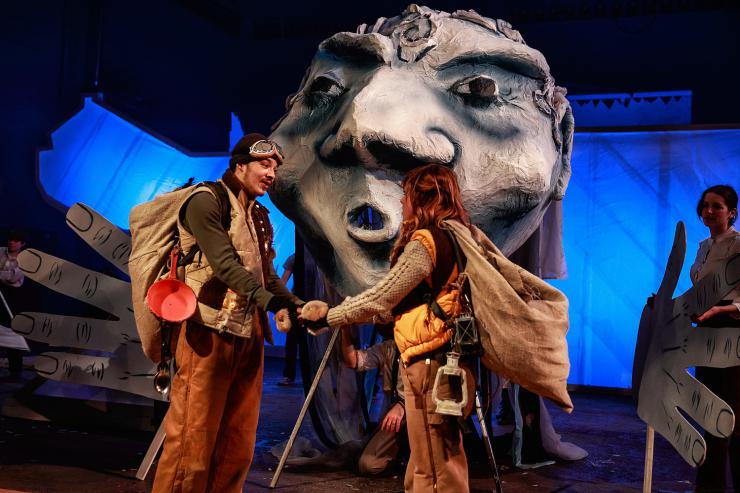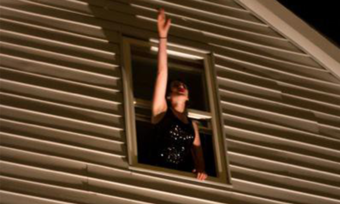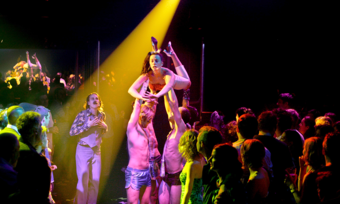Winter Pageant at Redmoon
The sound of birdsong fills Redmoon’s enormous new warehouse home in the Pilsen neighborhood of Chicago, as dozens of children swing on swings, build paper puppets of birds, and chase clowns around in circles. Their Winter Pageant, which ran December 13-22, is inspired by Farid ud-Din Atta’s twelfth-century Persian poem, “The Conference of the Birds” and tells the story of a pigeon who must retrieve the light needed to re-animate the Tree of Light after it is stolen by an evil raven.
Redmoon builds spectacle performance events, collaborating with multiple community partners to create large-scale interactive pieces. They tell stories using masks, puppets, machines, song, dance, circus techniques, and clowning; their aesthetic is singular and has been highly recognized. The aesthetic is whimsical and beautiful, and their work is full of symbolic meaning while also being easily accessible to a wide range of audiences—including, for Winter Pageant, an audience of diverse families. The performance event begins with open time for audience members to explore the space, interact with silent clown performers, make puppets, and enjoy free beverages in the large, open performance space.

featuring explorers Raphael Schwartzman and Danielle Nicholas. Photo by Ali Zayed.
This inviting opening invokes Redmoon’s artistic process, in which they create performances in collaboration with a diverse array of existing performance groups and artists highly skilled in a wide variety of performance styles. Directed by John Musial with Will Bishop and choreographed by Pranita Jain, Winter Pageant fuses Indian and Indonesian dance, hip-hop, clown acts, and circus performance, stitching together moments featuring the talents of highly skilled local performers in an organic and unified way. The Pigeon is played by Cordova Hernandez, a clown from Mexico City’s La Piara clown company. In addition to being an excellent sport about being chased through the space by a dozen children pre-show, he provides a humorous and nuanced portrait of a reluctant hero, rising to the occasion to save his community.
He is joined on his journey by the dove, played by Kinnari Vora, who is a Bharata Natyam (Classical Southern Indian) dancer. They are aided by friends variously disguised as a flock of birds dancing in classical Indian styles and a flock of birds dancing pop-and-lock hip hop (played by teenagers from The Happiness Club). The pigeon and the dove must make their way through obstacles including an aerial silk-swinging monkey and “The Sonic Boom,” a bike-pedaled machine featuring three teenage percussionists drumming on full drum kits. Ultimately, they reach the Phoenix, who can restore the light to the Tree. The Phoenix is played by aerialist Helena Reynolds, who restores the light in a spectacular aerial routine while lifted high above the audience’s heads by one of Redmoon’s singular machines. (Insert image).
During the performance, the audience is invited to participate in quiet but impactful ways. In one moment, the heroes are underwater. This landscape is invoked through shadow puppets and lighting and supported by a clown strapped into a bubble machine, who blows bubbles at the audience. The children sitting on the floor reach into the air for the bubbles. Against the onstage shadow puppets of ocean life and the live actors navigating the “underwater” environment, silhouettes of the children’s arms invoke images of seaweed, swaying in underwater currents. The children become part of the scenography, making meaning for audience members seated farther from the bubbles, as the children actively play along with the performance. At another moment, the evil Raven is defeated by a cannon shooting confetti. The children help “defeat” the Raven by scooping up confetti from their seats and throwing it at him. They are part of the action, playing along with the story in a way that is well managed by Redmoon’s expert actors.
After the performance, the audience is invited to greet the performers, examine the masks and costumes and props, eat some sweets, and continue to mingle. The space morphs into a big, loud, party of ethnically diverse families taking photos of loved ones, playing on the swings, and enjoying the space. This is appropriate, as the environment was built, in part, by community members participating in “Open Access Builds.” These volunteers received discounted tickets as a form of thanks for coming in to help Redmoon’s costume designer sew and create costumes and scenic artists build and paint backdrops for the production.
In this collaboration is a very real crossing of boundaries, bringing together artists, craftspeople, and audience members who might not otherwise have any access to each others’ s
This model of “community arts” is not rooted in the story circle—collaborating artists from diverse Chicago communities and volunteers helping to paint and sew do not write the allegorical script or determine the direction of the story of Winter Pageant. But in this collaboration is a very real crossing of boundaries, bringing together artists, craftspeople, and audience members who might not otherwise have any access to each others’ skills or experiences—and may not, indeed, know each other in a city as large as Chicago. Redmoon does not frame its work as “political”, but they build a safe space in which boundaries can be crossed.








Comments
The article is just the start of the conversation—we want to know what you think about this subject, too! HowlRound is a space for knowledge-sharing, and we welcome spirited, thoughtful, and on-topic dialogue. Find our full comments policy here
You mention everything except the fantastic live music. How could you miss that?